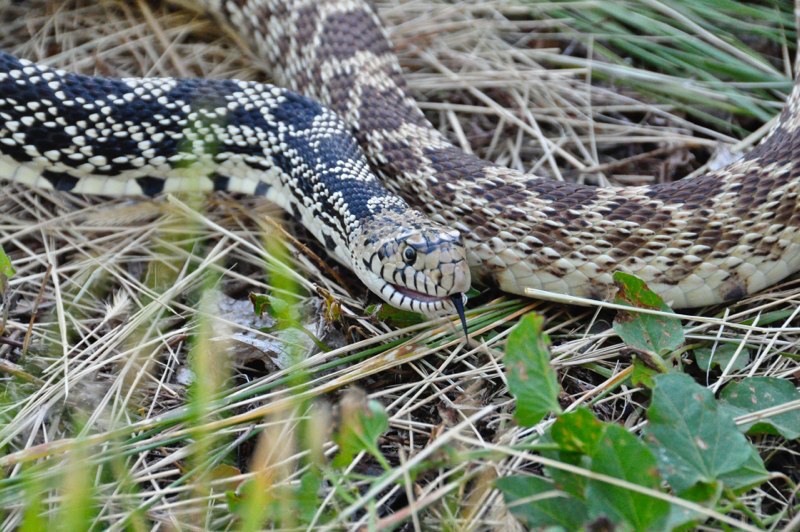Snake Ancestor Had Ankles and Toes

Millions of years ago, the common ancestor of all living snakes — a long creature with tiny hind limbs as well as ankles and toes — could be found slithering over the damp soil of forests in search of soft-bodied prey, a new study finds.
In the first comprehensive reconstruction of ancestral snakes, the researchers analyzed the fossils, DNA and anatomy of 73 species of snake and lizard.
Their findings suggest that the most recent common ancestor of snakes was likely nocturnal, evolved on land and lived in the warm, damp forests of the Southern Hemisphere about 128 million years ago, they said. [See Amazing Images of Snakes from Around the World]
The finding sheds light on the evolutionary history of snakes. Even though more than 3,400 snake species currently live on Earth in all sorts of habitats, little is known about where and when they developed, and how their original ancestor looked and behaved.
In addition to using genetic and anatomic data, the researchers "were able to take available data and backtrack through time to reconstruct what was the most likely behavior exhibited by the fossil snakes, given that the living snakes are behaving in this way," said Allison Hsiang, the study's lead researcher and a postdoctoral researcher of geology and geophysics at Yale University.
Hsiang and colleagues created an enormous snake family tree by identifying each species' similarities and differences. Their findings focused on the ancestor of all snakes and snakelike animals, as well as the legendary great granddaddy of only snakes.
Both ancestors likely hunted at night and ate "soft-bodied vertebrate and invertebrate prey" that was about the size of their heads, the researchers wrote in the study. Although their prey were relatively large compared to prey eaten by lizards at the time, it does not appear that these ancient creatures could constrict and manipulate prey larger than themselves, as the modern boa constrictor can, the researchers said. And unlike constrictors, these snake ancestors likely used needlelike teeth to snag prey before swallowing them whole.
Get the world’s most fascinating discoveries delivered straight to your inbox.
The ancestors also likely lived on land in "warm, well-watered and well-vegetated environments," they added.
However, the ancestor of all snakelike animals, which includes some lizards, likely developed during the middle of the Early Cretaceous period, about 128.5 million years ago, on Laurasia, a continent that included what is now North America, Europe and Asia, the researchers said.
The ancestor of all snakes followed about 20 million years later on the supercontinent Gondwana, which includes what is now South America, Africa, Antarctica and Australia, they said.
In fact, the rise of snakes coincided with the Cretaceous Terrestrial Revolution, when there was thought to be an intense diversification of animals, including insects, reptiles and mammals, Hsiang said.
The team also found that snakes used to be night owls. Although many ancestral reptiles were active during the daytime, the ancestral snake was nocturnal for about 45 million to 50 million years, they said. This nocturnal behavior likely stopped when Colubroidae, a family of snakes that makes up more than 85 percent of living snake species, stopped going out at night as temperatures dropped.
In fact, Colubroidae may have done so well because it could adapt to daytime activities, the researchers said.
Moreover, snakes may be successful at occupying different types of habitat because they can travel far and wide. Snakes can journey in ranges of about 42,500 square miles (110,000 square kilometers), which is about 4.5 times larger than the range of lizards. They can also live in both land and water, which has impeded the dispersal of other terrestrial animals, the researchers said.
The study was published online May 19 in the journal BMC Evolutionary Biology.
Follow Laura Geggel on Twitter @LauraGeggel. Follow Live Science @livescience, Facebook & Google+. Original article on Live Science.

Laura is the managing editor at Live Science. She also runs the archaeology section and the Life's Little Mysteries series. Her work has appeared in The New York Times, Scholastic, Popular Science and Spectrum, a site on autism research. She has won multiple awards from the Society of Professional Journalists and the Washington Newspaper Publishers Association for her reporting at a weekly newspaper near Seattle. Laura holds a bachelor's degree in English literature and psychology from Washington University in St. Louis and a master's degree in science writing from NYU.
 Live Science Plus
Live Science Plus






